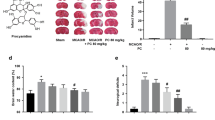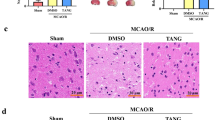Abstract
Narirutin (Nar) is a flavonoid that is abundantly present in citrus fruits and has attracted considerable attention because of its diverse pharmacological activities and low toxicity. Here, we evaluated the preventive effects of Nar in middle cerebral artery occlusion/reperfusion (MCAO/R)-injured mice and oxygen–glucose deprivation/reperfusion (OGD/R)-injured bEnd.3 cells. Pretreatment with Nar (150 mg/kg) for 7 days effectively reduced infarct volume, improved neurological deficits, and significantly inhibited neuronal death in the hippocampus and cortex in MCAO/R-injured mice. Moreover, anti-apoptotic effects of Nar (50 µM) were observed in OGD/R-injured bEnd.3 cells. In addition, Nar pre-administration regulated blood-brain barrier function by increasing tight junction-related protein expression after MCAO/R and OGD/R injury. Nar also inhibited NOD-like receptor protein 3 (NLRP3) inflammasome activation by reducing the expression of thioredoxin-interacting protein (TXNIP) in vivo and in vitro. Taken together, these results provide new evidence for the use of Nar in the prevention and treatment of ischemic stroke.
Graphical Abstract









Similar content being viewed by others
Data Availability
The data that support the findings of this study are available from the corresponding author upon reasonable request.
References
Haupt M, Gerner ST, Bähr M, Doeppner TR (2023) Neuroprotective strategies for ischemic stroke-future perspectives. Int J Mol Sci 24(5):4334. https://doi.org/10.3390/ijms24054334
Guo H, Yang J, Liu M, Wang L, Hou W, Zhang L, Ma Y (2020) Selective activation of estrogen receptor beta alleviates cerebral ischemia neuroinflammatory injury. Brain Res 1726:146536. https://doi.org/10.1016/j.brainres.2019.146536
Qin C, Yang S, Chu YH, Zhang H, Pang XW, Chen L, Zhou LQ, Chen M, Tian DS, Wang W (2022) Signaling pathways involved in ischemic stroke: molecular mechanisms and therapeutic interventions. Signal Transduct Target Ther 7(1):215. https://doi.org/10.1038/s41392-022-01064-1
Zhang P, Cui J (2021) Neuroprotective effect of fisetin against the cerebral ischemia-reperfusion damage via suppression of oxidative stress and inflammatory parameters. Inflammation 44(4):1490–1506. https://doi.org/10.1007/s10753-021-01434-x
Guo JM, Shu H, Wang L, Xu JJ, Niu XC, Zhang L (2017) SIRT1-dependent AMPK pathway in the protection of estrogen against ischemic brain injury. CNS Neurosci Ther 23(4):360–369. https://doi.org/10.1111/cns.12686
Duris K, Jurajda M (2020) Evolutionary concept of inflammatory response and Stroke. J Neurosci Res 98(1):98–104. https://doi.org/10.1002/jnr.24392
Barrington J, Lemarchand E, Allan SM (2017) A brain in flame; do inflammasomes and pyroptosis influence stroke pathology? Brain Pathol 27(2):205–212. https://doi.org/10.1111/bpa.12476
Cao BQ, Tan F, Zhan J, Lai PH (2021) Mechanism underlying treatment of ischemic stroke using acupuncture: transmission and regulation. Neural Regen Res 16(5):944–954. https://doi.org/10.4103/1673-5374.297061
Prakash R, Vyawahare A, Sakla R, Kumari N, Kumar A, Ansari MM, Kanika, Jori C, Waseem A, Siddiqui AJ, Khan MA, Robertson AAB, Khan R, Raza SS (2023) NLRP3 inflammasome-targeting nanomicelles for preventing ischemia-reperfusion-Induced Inflammatory Injury. ACS Nano 17(9):8680–8693. https://doi.org/10.1021/acsnano.3c01760
Wang L, Ren W, Wu Q, Liu T, Wei Y, Ding J, Zhou C, Xu H, Yang S (2022) NLRP3 inflammasome activation: a therapeutic target for cerebral ischemia-reperfusion Injury. Front Mol Neurosci 15:847440. https://doi.org/10.3389/fnmol.2022.847440
Franke M, Bieber M, Kraft P, Weber ANR, Stoll G, Schuhmann MK (2021) The NLRP3 inflammasome drives inflammation in ischemia/reperfusion injury after transient middle cerebral artery occlusion in mice. Brain Behav Immun 92:223–233. https://doi.org/10.1016/j.bbi.2020.12.009
Ismael S, Zhao L, Nasoohi S, Ishrat T (2018) Inhibition of the NLRP3-inflammasome as a potential approach for neuroprotection after stroke. Sci Rep UK. https://doi.org/10.1038/s41598-018-24350-x
Bellut M, Papp L, Bieber M, Kraft P, Stoll G, Schuhmann MK (2022) NLPR3 inflammasome inhibition alleviates hypoxic endothelial cell death in vitro and protects blood-brain barrier integrity in murine stroke. Cell Death Dis. https://doi.org/10.1038/s41419-021-04379-z
Li L, Cheng SQ, Guo W, Cai ZY, Sun YQ, Huang XX, Yang J, Ji J, Chen YY, Dong YF, Cheng H, Sun XL (2021) Oridonin prevents oxidative stress-induced endothelial injury via promoting Nrf-2 pathway in ischaemic Stroke. J Cell Mol Med 25(20):9753–9766. https://doi.org/10.1111/jcmm.16923
Zhou R, Tardivel A, Thorens B, Choi I, Tschopp J (2010) Thioredoxin-interacting protein links oxidative stress to inflammasome activation. Nat Immunol 11(2):136–140. https://doi.org/10.1038/ni.1831
Ishrat T, Mohamed IN, Pillai B, Soliman S, Fouda AY, Ergul A, El-Remessy AB, Fagan SC (2015) Thioredoxin-interacting protein: a novel target for neuroprotection in experimental thromboembolic stroke in mice. Mol Neurobiol 51(2):766–778. https://doi.org/10.1007/s12035-014-8766-x
Abais JM, **a M, Li G, Chen Y, Conley SM, Gehr TWB, Boini KM, Li PL (2014) Nod-like receptor protein 3 (NLRP3) inflammasome activation and podocyte injury via thioredoxin-interacting protein (TXNIP) during hyperhomocysteinemia. J Biol Chem 289(39):27159–27168. https://doi.org/10.1074/jbc.M114.567537
Wang X, Li R, Wang X, Fu Q, Ma S (2015) Umbelliferone ameliorates cerebral ischemia-reperfusion injury via upregulating the PPAR gamma expression and suppressing TXNIP/NLRP3 inflammasome. Neurosci Lett 600:182–187. https://doi.org/10.1016/j.neulet.2015.06.016
Olas B (2021) A review of in vitro studies of the anti-platelet potential of citrus fruit flavonoids. Food Chem Toxicol. https://doi.org/10.1016/j.fct.2021.112090
Funaguchi N, Ohno Y, La BL, Asai T, Yuhgetsu H, Sawada M, Takemura G, Minatoguchi S, Fujiwara T, Fujiwara H (2007) Narirutin inhibits airway inflammation in an allergic mouse model. Clin Exp Pharmacol Physiol 34(8):766–770. https://doi.org/10.1111/j.1440-1681.2007.04636.x
Ha SK, Park HY, Eom H, Kim Y, Choi I (2012) Narirutin fraction from citrus peels attenuates LPS-stimulated inflammatory response through inhibition of NF-kappaB and MAPKs activation. Food Chem Toxicol 50(10):3498–3504. https://doi.org/10.1016/j.fct.2012.07.007
Chakraborty S, Basu S (2017) Multi-functional activities of citrus flavonoid narirutin in Alzheimer’s disease therapeutics: an integrated screening approach and in vitro validation. Int J Biol Macromol 103:733–743. https://doi.org/10.1016/j.ijbiomac.2017.05.110
Mitra S, Lami MS, Uddin TM, Das R, Islam F, Anjum J, Hossain MJ, Emran TB (2022) Prospective multifunctional roles and pharmacological potential of dietary flavonoid narirutin. Biomed Pharmacother 150:112932. https://doi.org/10.1016/j.biopha.2022.112932
Wong ES, Li RW, Li J, Li R, Seto SW, Lee SM, Leung GP (2021) Relaxation effect of narirutin on rat mesenteric arteries via nitric oxide release and activation of voltage-gated potassium channels. Eur J Pharmacol 905:174190. https://doi.org/10.1016/j.ejphar.2021.174190
Patel P, Barve K, Bhatt LK (2022) Narirutin-rich fraction from grape fruit peel protects against transient cerebral ischemia reperfusion injury in rats. Nutr Neurosci 25(5):920–930. https://doi.org/10.1080/1028415X.2020.1821518
Ri MH, Li MY, **ng Y, Zuo HX, Li G, Li C, Ma J, ** X (2023) Narirutin exerts anti-inflammatory activity by inhibiting NLRP3 inflammasome activation in macrophages. Phytother Res 37(4):1293–1308. https://doi.org/10.1002/ptr.7686
Yu JY, Liu QQ, Li X, Zhao M, Sun T, Hu N, Jiang W, Zhang RT, Yang P, Yang Q (2021) Oxymatrine improves blood-brain barrier integrity after cerebral ischemia-reperfusion injury by downregulating CAV1 and MMP9 expression. Phytomedicine 84:153505. https://doi.org/10.1016/j.phymed.2021.153505
Fu C, Wu Y, Liu S, Luo C, Lu Y, Liu M, Wang L, Zhang Y, Liu X (2022) Rehmannioside A improves cognitive impairment and alleviates ferroptosis via activating PI3K/AKT/Nrf2 and SLC7A11/GPX4 signaling pathway after ischemia. J Ethnopharmacol 289:115021. https://doi.org/10.1016/j.jep.2022.115021
Yu L, Zhang Y, Chen Q, He Y, Zhou H, Wan H, Yang J (2022) Formononetin protects against inflammation associated with cerebral ischemia-reperfusion injury in rats by targeting the JAK2/STAT3 signaling pathway. Biomed Pharmacother 149:112836. https://doi.org/10.1016/j.biopha.2022.112836
Fu C, Wu Y, Liu S, Luo C, Lu Y, Liu M, Wang L, Zhang Y, Liu X (2022) Rehmannioside A improves cognitive impairment and alleviates ferroptosis via activating PI3K/AKT/Nrf2 and SLC7A11/GPX4 signaling pathway after ischemia. J Ethnopharmacol. https://doi.org/10.1016/j.jep.2022.115021
Luo L, Sun T, Yang L, Liu A, Liu QQ, Tian QQ, Wang Y, Zhao MG, Yang Q (2020) Scopoletin ameliorates anxiety-like behaviors in complete Freund’s adjuvant-induced mouse model. Mol Brain 13(1):15. https://doi.org/10.1186/s13041-020-0560-2
Gottschall PE, Barone FC (2012) Important role for endothelial calveolin-1 in focal cerebral ischemia-induced blood-brain barrier injury. J Neurochem 120(1):4–6. https://doi.org/10.1111/j.1471-4159.2011.07546.x
Khatri R, McKinney AM, Swenson B, Janardhan V (2012) Blood-brain barrier, reperfusion injury, and hemorrhagic transformation in acute ischemic stroke. Neurology 79(Suppl 1):S52-57. https://doi.org/10.1212/WNL.0b013e3182697e70
Ng F, Churilov FC, Yassi L, Kleinig N, Thijs TJ, Wu V, Shah TY, Dewey DG, Sharma HM, Desmond G, Yan PM, Parsons B, Donnan MW, Davis GA, Mitchell SM, Leigh PJ, Campbell R, EXTEND-IA TNK Part 1 and 2 Investigators (2022) Microvascular dysfunction in blood-brain barrier disruption and hypoperfusion within the Infarct posttreatment are associated with cerebral edema. Stroke 53(5):1597–1605. https://doi.org/10.1161/STROKEAHA.121.036104
Cardoso FL, Brites D, Brito MA (2010) Looking at the blood-brain barrier: molecular anatomy and possible investigation approaches. Brain Res Rev 64(2):328–363. https://doi.org/10.1016/j.brainresrev.2010.05.003
Reinhold AK, Rittner HL (2017) Barrier function in the peripheral and central nervous system-a review. Pflugers Arch 469(1):123–134. https://doi.org/10.1007/s00424-016-1920-8
Cao G, Jiang N, Hu Y, Zhang Y, Wang G, Yin M, Ma X, Zhou K, Qi J, Yu B, Kou J (2016) Ruscogenin attenuates cerebral ischemia-induced blood-brain barrier dysfunction by suppressing TXNIP/NLRP3 inflammasome activation and the MAPK pathway. Int J Mol Sci 17(9). https://doi.org/10.3390/ijms17091418
Kawabori M, Yenari MA (2015) Inflammatory responses in brain ischemia. Curr Med Chem 22(10):1258–1277. https://doi.org/10.2174/0929867322666150209154036
Pei J, You X, Fu Q (2015) Inflammation in the pathogenesis of ischemic Stroke. Front Biosci (Landmark Ed) 20(4):772–783. https://doi.org/10.2741/4336
Pan W, Kastin AJ (2007) Tumor necrosis factor and stroke: role of the blood-brain barrier. Prog Neurobiol 83(6):363–374. https://doi.org/10.1016/j.pneurobio.2007.07.008
Hou Y, Wang Y, He Q, Li L, **e H, Zhao Y, Zhao J (2018) Nrf2 inhibits NLRP3 inflammasome activation through regulating Trx1/TXNIP complex in cerebral ischemia reperfusion injury. Behav Brain Res 336:32–39. https://doi.org/10.1016/j.bbr.2017.06.027
Yang F, Wang Z, Wei X, Han H, Meng X, Zhang Y, Shi W, Li F, **n T, Pang Q, Yi F (2014) NLRP3 deficiency ameliorates neurovascular damage in experimental ischemic Stroke. J Cereb Blood Flow Metab 34(4):660–667. https://doi.org/10.1038/jcbfm.2013.242
Funding
This work was supported by the Key Research and Development Plan of Shaanxi Province, China (2020SF-142) and the National Natural Science Foundation of China Tangdu Hospital (2021ZTXM-033).
Author information
Authors and Affiliations
Contributions
MZ and AL conceived the study. LL and SW contributed to the experiments. WL and ZZ performed the data analysis. LL drafted and edited the manuscript. All authors read and approved the final version.
Corresponding authors
Ethics declarations
Conflict of interest
The authors declare that they have no conflict of interest.
Additional information
Publisher’s Note
Springer Nature remains neutral with regard to jurisdictional claims in published maps and institutional affiliations.
Supplementary Information
Below is the link to the electronic supplementary material.
Rights and permissions
Springer Nature or its licensor (e.g. a society or other partner) holds exclusive rights to this article under a publishing agreement with the author(s) or other rightsholder(s); author self-archiving of the accepted manuscript version of this article is solely governed by the terms of such publishing agreement and applicable law.
About this article
Cite this article
Luo, L., Wang, S., Liu, W. et al. Narirutin Attenuates Cerebral Ischemia-Reperfusion Injury by Suppressing the TXNIP/NLRP3 Pathway. Neurochem Res 49, 692–705 (2024). https://doi.org/10.1007/s11064-023-04062-z
Received:
Revised:
Accepted:
Published:
Issue Date:
DOI: https://doi.org/10.1007/s11064-023-04062-z




